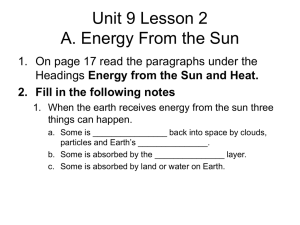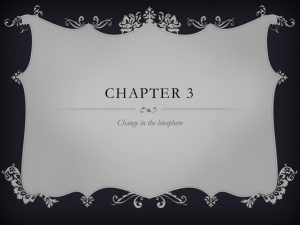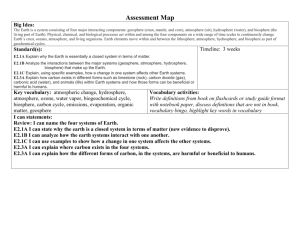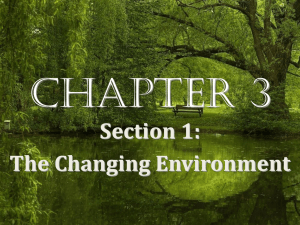Study Guide - TeacherWeb
advertisement
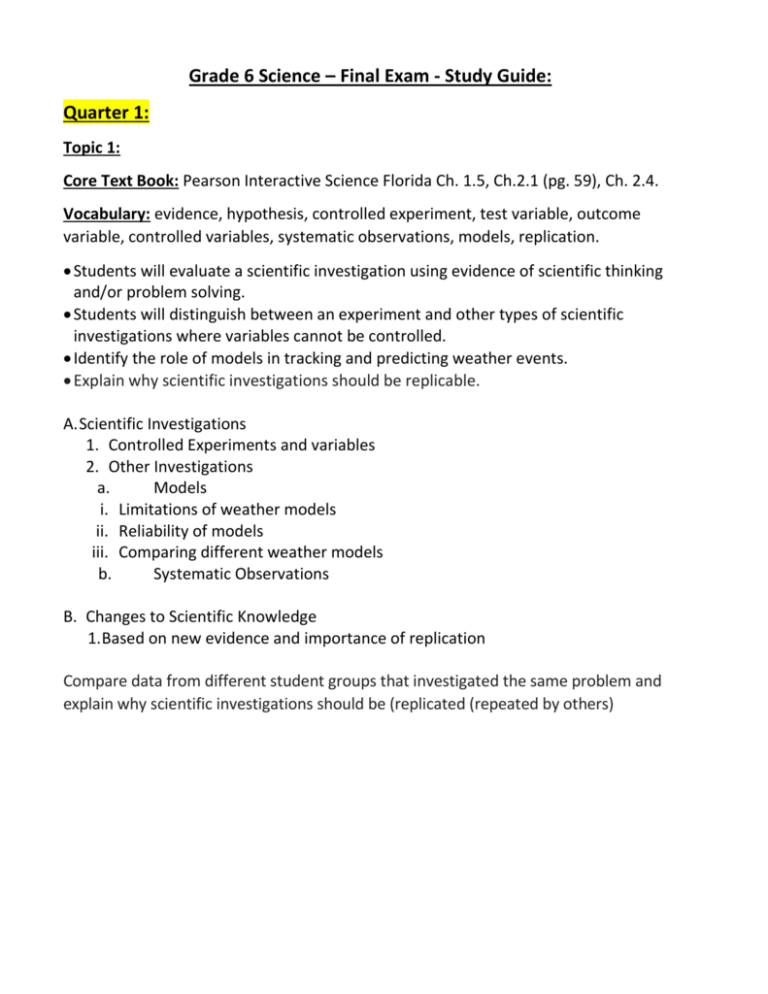
Grade 6 Science – Final Exam - Study Guide: Quarter 1: Topic 1: Core Text Book: Pearson Interactive Science Florida Ch. 1.5, Ch.2.1 (pg. 59), Ch. 2.4. Vocabulary: evidence, hypothesis, controlled experiment, test variable, outcome variable, controlled variables, systematic observations, models, replication. Students will evaluate a scientific investigation using evidence of scientific thinking and/or problem solving. Students will distinguish between an experiment and other types of scientific investigations where variables cannot be controlled. Identify the role of models in tracking and predicting weather events. Explain why scientific investigations should be replicable. A. Scientific Investigations 1. Controlled Experiments and variables 2. Other Investigations a. Models i. Limitations of weather models ii. Reliability of models iii. Comparing different weather models b. Systematic Observations B. Changes to Scientific Knowledge 1. Based on new evidence and importance of replication Compare data from different student groups that investigated the same problem and explain why scientific investigations should be (replicated (repeated by others) Topic 2: Core Text Book: Pearson Interactive Science Florida Ch. 7.4, Ch. 2.4 Vocabulary: Weather, natural disaster, hurricane, storm surge, flood, wildfire, drought, sinkholes, atmosphere, pressure, precipitation, model, evidence, latitude, longitude Analyze the effects of hurricanes on life and property. Investigate the effects of other natural disasters, such as tornadoes, floods, fires, droughts, and sinkholes on life and property. Utilize models to analyze to effects of natural disasters on populations. Identify and explain appropriate methods of protection from hazardous weather and conditions. Research and interpret important disaster preparedness information Identify the harmful effects of sun exposure and explain how to protect yourself from the sun. B. Hurricanes 1. Effects on Life/Property 2. Tracking Models limitations, reliability, comparing different models C. Other natural disasters 1)Tornadoes 2) Floods 3) Fires 4) Sinkholes 5) Drought D. Hazard Preparation 1. Emergency Preparedness and 2. Effects of Sun Exposure UV light and radiation and skin protection Topic 3: Core Text Book: Pearson Interactive Science Florida Ch. 1. Ch. 5.1 and Ch. 5.2 Vocabulary: Ultraviolet, radiation, thermal energy, heat, temperature, conduction, convection, atmosphere, hydrosphere, condensation, evaporation, precipitation, percolation, transpiration, infiltration Identify, compare, and contrast temperature, heat and thermal energy. Compare and contrast convection, conduction, and radiation in the Sun and Earth systems, and other real-world systems. Analyze how conduction, convection, and radiation drive the water cycle in Earth’s systems. Students will create and analyze how a classroom created model of the water cycle is different from and similar to the water cycle on Earth. Evaluate a scientific investigation using evidence of scientific thinking/ problem solving. A. Heat Transfer in Earth’s Systems 1. Temperature vs. Thermal Energy 2. Conduction 3. Convection 4. Radiation B. Water Cycle 1. Evaporation 2. Condensation 3. Transpiration 4. Precipitation 5. Percolation Compare and contrast convection, conduction and radiation in both the Sun’s and Earth’s systems (atmosphere, hydrosphere, cryosphere, geosphere). Topic 4: Core Text Book: Pearson Interactive Science Florida Ch. 5.3, 5.6 Vocabulary: jet stream, ocean currents, air pressure, wind, humidity, latitude, altitude, barometer, anemometer, psychrometer, precipitation, rain gauge, gulfstream, temperature, weather, climate Relate how energy provided by the Sun influences global patterns of atmospheric movement and the temperature differences among air, water, and land. Explain how convection currents cause wind and wind patterns Recognize how global patterns influence both weather and climate Describe the effect of the jet stream and ocean currents on local weather patterns Compare and contrast methods and/or results obtained in a scientific investigation Differentiate between weather and climate A. Sun’s Influences on Atmospheric Movement 1. Heating of air, water and land 2. Convection currents (winds) a. Wind Direction 1. Land breeze vs. Sea breeze B. Global Patterns That Affect Weather 1. Ocean Currents: Gulf Stream and Jet Stream 2. Measurable weather conditions a. Humidity b. Precipitation c. Temperature d. Air Pressure e. Wind direction and speed C. Weather vs. Climate 1. Weather as daily conditions and climate as the pattern of weather over time I am able to recognize relationships among Earth’s spheres, including cycling of water and global patterns that influence both weather and climate. Topic 5: Core Text Book: Pearson Interactive Science Florida Ch.7.1 – 7.3 and 7.5 - 7.6 Vocabulary system, atmosphere, hydrosphere, geosphere, cryosphere, biosphere, radiation, electromagnetic waves, global winds, convection currents, weather, climate, atmosphere, troposphere, stratosphere, mesosphere, thermosphere, ionosphere, exosphere, ozone hole, greenhouse effect, greenhouse gas, global warming Recognize relationships among Earth’s spheres, including cycling of water and global patterns that influence both weather and climate Differentiate and/or explain interactions among the geosphere, hydrosphere, cryosphere, atmosphere and biosphere. Identify and describe the composition and structure of the atmosphere and how the atmosphere protects life and insulates the planet Compare and contrast the different layers of the atmosphere and present information in small groups. Model the layers of the atmosphere. Relate how energy provided by the Sun influences global patterns of atmospheric movement and temperature differences between air, water, and land Differentiate between weather and climate. Classify the different climate regions of the world and the factors that influence them. Investigate and evaluate the function of the ozone layer. Explain that a scientific theory is a well supported and widely accepted explanation of nature A. Earth’s Spheres 1) Geosphere 2) Hydrosphere 3) Cryosphere 4) Atmosphere 5) Biosphere B.Composition, Structure, and Function of the Atmosphere 1) Composition and layers of the Atmosphere 2) Energy in Earth’s Atmosphere C. Human Activities and Climate Change 1) Ozone Layer, 2) Greenhouse Effect, and Global Warning Quarter 2: Topic 6: Core Text Book: Pearson Interactive Science Florida Ch. 3.1; 3.3 and Ch. 4.1 – 4.4 Vocabulary: physical weathering, ice wedging, abrasion, chemical weathering, oxidation, carbonation, acid precipitation, erosion, sheet erosion, glacier, glacial erosion, mass movement, deposition, acid rain, sediment, limestone, permeable, sand dune, sand bar. Differentiate among weathering, erosion, and deposition Describe and explain how Earth’s surface is built up and torn down through the processes of physical and chemical weathering, erosion, and deposition Investigate local landforms that were developed as a result of erosion and deposition Differentiate and describe the various interactions among Earth systems contributes to weathering and erosion (i.e., atmosphere, hydrosphere, cryosphere, geosphere, geosphere, and biosphere) Differentiate between the different types of landforms on Earth’s surface and relate these landforms as they apply to Florida 1. Weathering 1. Physical weathering (Types and Effects) 2. Chemical weathering (Types and Effects) B. Erosion A. Agents of Erosion B. Wind erosion C. Water erosion D. Glacial erosion E. Land/Mud slides C. Deposition D. Types of Landforms 2. Mountains, Rivers, Deltas, Lakes, Coastlines, Dunes, Glaciers E. Florida Landforms 1. Coastal features (sandbars, barrier islands, beaches/dunes) 2. Wetlands, Ridges, Hills, Rivers/Lakes, and Sinkholes Topic 7: Core Text Book: Pearson Interactive Science Florida Ch. 8.1 – 8.2 and Ch. 2 Vocabulary: energy, kinetic energy, potential energy, gravitational potential energy, elastic potential energy, joule, mass, energy transformation, mechanical energy, Law of Conservation of Energy, heat, law (scientific law) A. Compare and contrast potential and kinetic energy B. Identify everyday examples of the Law of Conservation of Energy. C. Explain why The Law of Conservation of Energy is a law and a not a theory. D. Explore and diagram the transformation of potential energy into kinetic energy and vice versa using real life examples (i.e. pendulum). E. Explain the reduction of available energy to a system during an energy transfer Potential Energy Gravitational Potential Energy Elastic Potential Energy Kinetic Energy Energy of motion Law of Conservation of Energy 1. Law vs. theory 2. Energy Transformations 3. From potential to kinetic 4. From kinetic to potential Topic 8: Core Text Book: Pearson Interactive Science Florida Ch. 8.3 – 8.5 Vocabulary: motion, speed, velocity, distance, displacement, kilometer, seconds, acceleration, positive acceleration, negative acceleration, constant speed Create original graphs from recorded distance and time and interpret motion of objects Interpret and/or analyze graphs of distance and time for an object moving at a constant speed Differentiate between average speed, instantaneous speed and constant speed to describe a trip Identify changes in speed as positive acceleration or negative acceleration Students will evaluate a the motion of an object using evidence from scientific investigations A. Measuring speed and distance 1. Motion as a change in position 2. Measuring distance and time 3. Relationship between distance and time 4. Calculate speed and average speed B. Constructing and Analyzing Distance vs. Time Graphs 1. Motion a. Forwards b. Backwards c. Standing Still 2. Comparing Speeds Topic 9: Core Text Book: Pearson Interactive Science Florida Ch. 9.1 (pages 328-332) Vocabulary: contact forces, applied force, normal force, friction, gravity, magnetic force, electrical force, air resistance Identify and describe types of forces Distinguish between different contact forces. Distinguish between different forces that act at distance. Evaluate forces acting on different objects and how different surfaces can affect the amount of friction. Describe and illustrate how electrical charges interact. Describe and illustrate how magnetic poles interact Describe and illustrate how gravity acts on an object A. Contact Forces 1. Applied force (push or pull) 2. Normal force 3. Friction 4. Air resistance 5. Buoyant force B. Forces Acting at a Distance 1. Electrical force 2. Magnetic force 3. Gravity Quarter 3: Topic 10: Core Text Book: Pearson Interactive Science Florida Ch. 9.1 (pgs. 333 – 335) Vocabulary: gravity, force, mass, weight, Newton, distance Identify gravity as the force that causes objects to fall to Earth Differentiate between mass and weight Investigate the Law of Universal Gravitation through models Relate distance and mass to the gravitational force between any two objects A. Gravitational Force B. Mass vs. Weight C. Newton’s Law of Universal Gravitation 1. Relationship between: a. Mass b. Distance Topic 11: Core Text Book: Pearson Interactive Science Ch. 9.2 - 9.3 Vocabulary: force, newtons, motion, unbalanced forces, balanced forces, velocity, friction, acceleration, net force, positive acceleration, negative acceleration, vector • Recognize that an unbalanced force acting on an object changes its speed and/or direction • Identify the effect of balanced and unbalanced forces acting on different objects like a skateboard or soccer ball • Analyze parallel forces acting on an object to calculate net force • Compare and contrast positive acceleration and negative acceleration • Create and analyze a distance vs. time graph of an object moving at constant speed • Analyze a distance vs. time graph with up to four objects moving at a constant speed • Assess the relative speed of an object at various points or sections on a graph and determine the direction of motion. A. Forces 1. Unbalanced 2. Balanced 3. Net Force B. Effects of Unbalanced Forces on an Object 1. Change in Speed 2. Change in Direction Topic 12: Identify patterns in the hierarchical organization of organisms from atoms to organisms Match a particular structure to the appropriate level (e.g. heart to organ, cactus to organism, muscle to tissue) Identify, describe, and explain the components of the Cell Theory Compare and contrast single-celled and multi-cellular organisms Describe how the cells of organisms function to maintain homeostasis A. 1. 2. 3. 4. 5. Hierarchical Organization of Organisms Atoms to molecules Cells to tissues Tissues to organs Organs to organ systems Organ System to Organism B. Cell Theory 1. All organisms are composed of cells 2. All cells come from pre-existing cells 3. Cells are basic unit of life C. Homeostasis 1. Energy extraction from food 2. Removal of waste by cells 3. Cell reproduction overview Topic 13: Core Text Book: Pearson Interactive Science Florida Ch. 10.4 Vocabulary: organelle, cell membrane, nucleus, cytoplasm, chloroplasts, mitochondria, vacuoles, cell wall, photosynthesis, prokaryotic, eukaryotic, homeostasis, cellular respiration Compare and contrast prokaryotic and eukaryotic cells Identify basic structures that most cells share Compare and contrast the structure and function of the major organelles of plant and animal cells Distinguish plant cells from animal cells using the differences in organelles Develop a model of a cell and show the major cell organelles and identify their functions. A. Prokaryotic and Eukaryotic Cells B. Organelles of All Eukaryotic Cells 1. Cell membrane 2. Nucleus 3. Cytoplasm 4. Mitochondria 5. Vacuoles C. Plants Specific Organelles 1. Cell wall 2. Chloroplast 3. Large central vacuole Topic 14: Core Text Book: Pearson Interactive Science Ch. 10.1 and Ch. 15 Vocabulary: organism, tissue, organs, organ systems, atoms, molecule, cells, hierarchy, taxonomy, binomial nomenclature, Linnaean system, domain, kingdom, phylum, class, order, family, genus, species, classification, eukaryote, prokaryote Analyze and describe how and why organisms are classified according to shared characteristics Identify the organization of the Linnaean system from domain to species Investigate the characteristics of individual domains and kingdoms Classify organisms into domains and kingdoms according to characteristics Explain why scientists use binomial nomenclature to name organisms A. Linnaean Classification System 1. Domains to species B. Characteristics of living things 1. Domains a Bacteria b Archaea c Eukarya 2. Eukaryotic Kingdoms a Protist b Fungus c Plant d Animal C. Scientific Name Binomial nomenclature (Genus & species) Quarter 4: Topic 15: Core Text Book: Pearson Interactive Science Florida Ch. 11 – 13 Vocabulary: homeostasis, organ, tissue, cell, hormones, skeleton, digestion, respiratory circulatory, excretory, digestive, musculoskeletal, immune, endocrine, reproductive, and nervous system Identify the general function of the major body systems Investigate and connect the function of the major body systems to how they interact to maintain homeostasis Explain the effects of drugs on the various body systems A. Major body systems and their functions 1. Musculoskeletal System 2. Nervous System 3. Digestive System 4. Respiratory System 5. Excretory System 6. Circulatory System 7. Immune System 8. Reproductive System B. Interactions of the major body systems to maintain homeostasis C. Effects of drugs on body systems Topic 16: Core Text Book: Pearson Interactive Science Florida Ch. 14; Vocabulary: virus, bacteria, fungus, parasite, immunity, microorganism, infectious disease, pathogen, antibody, antigen, incubation, transmission, communicable Identify, compare and contrast the types of infectious agents that affect the human body Compare and contrast the ways bacteria and viruses affect different organisms. Compare different types of infectious agents and how they infect the human body Recognize that bacteria and viruses can infect the human body through many different modes of transmission including airborne, blood borne, body fluids, etc. A. Infectious agents 1. Viruses a. Requires a host 2. Bacteria 3. Fungi 4. Parasites B. Disease Prevention
